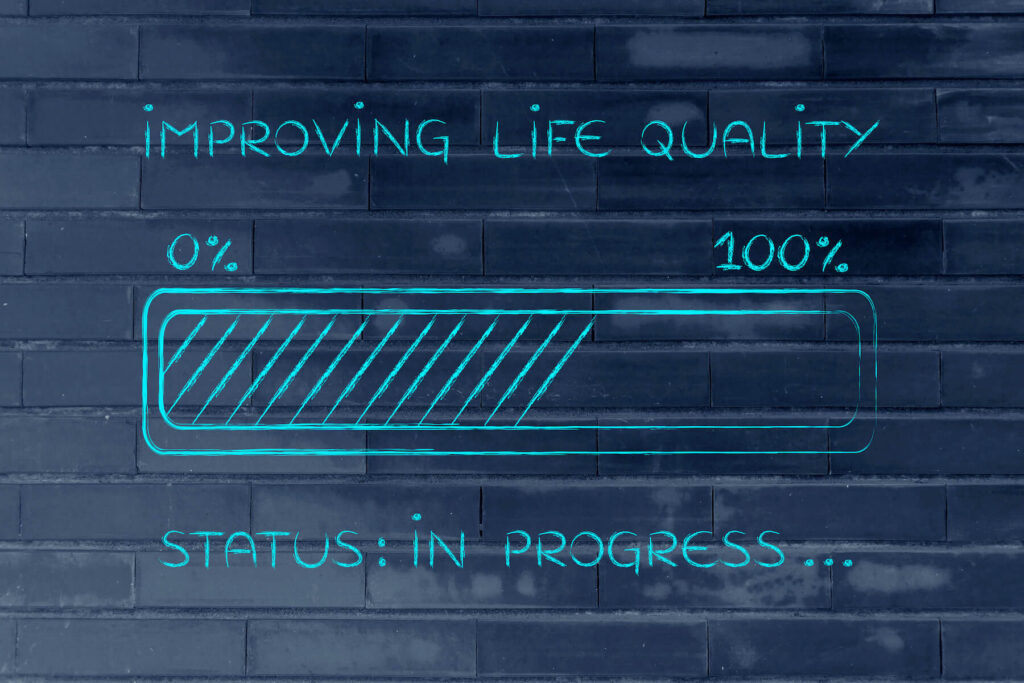Many of us struggle with negative self-talk—an inner critic that savagely sabotages us with doubts and harsh judgments. We’re our own worst enemy.
We think we’re struggling with the outer game but it’s actually the inner game that’s tripping us up.
“Happiness is an inside game, literally and neurochemically.”
-Shirzad Chamine, executive and best-selling author
How to Stop Our Negative Self-Talk
There are many things we can do to hush the inner critic in our head.
- Doing breath work: breathing deeply and intentionally (as in yoga, meditation, and “box breathing”). This will change our physical and mental state.
“Breath is the bridge which connects life to consciousness, which unites your body to your thoughts. Whenever your mind becomes scattered, use your breath as the means to take hold of your mind again.”
-Thich Nhat Hanh, The Miracle of Mindfulness
- Noticing our thoughts more: observing the things that pop into our heads and spotting the negative patterns that reappear. It helps to label them (e.g., “I’m being overly critical again”) and let them go.
- Practicing self-compassion: treating ourselves with understanding and warmth in difficult times and recognizing that we all make mistakes. With self-compassion, we can give ourselves grace, forgive ourselves, and move on.
- Being curious about or fascinated with the issue we’re concerned about—a more positive frame.

Take the Traps Test
We all fall into traps in life. Sometimes we’re not even aware of it, and we can’t get out of traps we don’t know we’re in. Evaluate yourself with our Traps Test.
- Remaining open to new possibilities and alternate interpretations that don’t involve harsh self-judgment.
- Focusing on what we can control, and not worrying about the rest. (Consider reciting the “serenity prayer.”)
- Avoiding the trap of catastrophizing (assuming the worst or exaggerating our flaws).
- Changing our context to bring a different perspective and renewed energy.

Quality of Life Assessment
Evaluate your quality of life in ten key areas by taking our assessment. Discover your strongest areas, and the areas that need work, then act accordingly.
- Asking questions to understand why we’re feeling a certain way and how things might be changed.
- Replacing our inner critique with a more charitable and helpful narrative.
- Cognitive reframing: shifting our mindset to look at a situation or relationship from a different and more helpful perspective, such as redefining a problem as a challenge or a puzzle or mystery that we can solve.
- Playing and having fun. (Play often changes our physiology by moving us into a state of deep engagement or flow.)
- Taking action. This naturally interrupts our negative self-talk and rumination and focuses us on our context and next move.
- Choosing what to think and be mindful about. Many people become victims of the thought-stream in their minds instead of engaging their “observer” or “witness consciousness” to observe their thoughts and let them go.
“What a liberation to realize that the ‘voice in my head’ is not who I am.
Who am I then? The one who sees that.”
-Eckhart Tolle, German spiritual teacher and author
- Changing the channel on negative thoughts. Sometimes it helps to use a pattern interruption technique like swiping our hand to the side, symbolically signaling that we’re dismissing our negative self-talk.
“Our life is what our thoughts make it.”
-Marcus Aurelius, Meditations
Reflection Questions
- Is your self-talk too negative?
- What techniques will you try to address it?

Personal Values Exercise
Complete this exercise to identify your personal values. It will help you develop self-awareness, including clarity about what’s most important to you in life and work, and serve as a safe harbor for you to return to when things are tough.
Tools for You
- Traps Test (Common Traps of Living) to help you identify what’s getting in the way of your happiness and quality of life
- Quality of Life Assessment to help you discover your strongest areas and the areas that need work and then act accordingly
- Personal Values Exercise to help you clarify what’s most important to you
Related Traps and Articles
- Mental Prisons We Build for Ourselves
- Overthinking, Rumination, and Worrying
- The “Trance of Unworthiness”
- Fear
- The Conformity Trap
- Caring Too Much about What Other People Think
- Settling
- Feeling Behind? It May Be a Trap
- The Comparison Trap
- Monkey Mind
- Neediness
- Catastrophizing
- The Power of Reframing
Appendix: Support Resources
- BetterHelp (online network of licensed therapists)
- SonderMind (connecting people with therapists)
- Befrienders Worldwide (helplines outside the U.S.)
- 7cups (a free help network)

Gregg Vanourek’s Newsletter
Join our rapidly growing community. Sign up now and get monthly inspirations (new articles, opportunities, and resources). Welcome!
++++++++++++++++++++++++++++++
Gregg Vanourek is a writer, teacher, TEDx speaker, and coach on leadership and personal development. He is co-author of three books, including LIFE Entrepreneurs: Ordinary People Creating Extraordinary Lives (a manifesto for integrating our life and work with purpose, passion, and contribution) and Triple Crown Leadership: Building Excellent, Ethical, and Enduring Organizations (a winner of the International Book Awards). Check out his Best Articles or get his monthly newsletter. If you found value in this article, please forward it to a friend. Every little bit helps!


1 thought on “How to Stop Our Negative Self-Talk: 15 Practices”
I’ve been gradually moving in this direction through action/results ,trial and error but it seems to be taking a lifetime. So if information, technique, method,practices…are presented its that much more helpful. The Negative voice has not been a friend to me my life. So I’m going to apply these principles and practices. Jwalsh